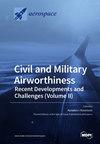Numerical Study on Far-Field Noise Characteristic Generated by Wall-Mounted Swept Finite-Span Airfoil within Transonic Flow
IF 2.1
3区 工程技术
Q2 ENGINEERING, AEROSPACE
引用次数: 0
Abstract
This study seeks to develop a fundamental comprehension of the noise challenges encountered by commercial aircraft fuselage surface attachments, such as blade antennas and pitot tubes. The study examines the flow characteristics and far-field noise directivity of a wall-mounted NACA0012 airfoil with various sweep angles (−35°, −15°, 0°, +15°, and +35°) and an aspect ratio of 1.5. The Mach numbers of the incoming flow range from 0.8 to 0.9 with a Reynolds number of about 7 × 105. Delayed Detached Eddy Simulation (DDES) and the Ffowcs Williams–Hawkings (FW-H) equation are utilized. The results show that the shock wave intensity at the junction between the airfoil and the bottom wall is enhanced by the forward-swept angle. The shock wave moves and changes into a λ-type structure, while the boundary layer separates and produces shedding vortices in the junction at a smaller Mach number on the forward-swept airfoil compared to the straight airfoil and the backward-swept airfoil. These phenomena cause significant surface pressure fluctuations in the junction and result in a significant dipole noise in the far field, which is the primary source of noise in the far field. In addition, the normal Mach number and the absolute sweep angle also contribute to the far-field noise.壁挂式横扫有限跨度翼面在跨音速气流中产生的远场噪声特性的数值研究
本研究旨在从根本上了解商用飞机机身表面附件(如叶片天线和皮托管)所遇到的噪声挑战。该研究考察了具有不同扫描角度(-35°、-15°、0°、+15°和+35°)和长宽比为 1.5 的壁装 NACA0012 翼面的流动特性和远场噪声指向性。流入气流的马赫数在 0.8 到 0.9 之间,雷诺数约为 7 × 105。采用了延迟分离涡模拟(DDES)和 Ffowcs Williams-Hawkings (FW-H) 方程。结果表明,机翼与底壁交界处的冲击波强度因前掠角而增强。与直机翼和后掠机翼相比,前掠机翼的马赫数较小,冲击波移动并转变为 λ 型结构,同时边界层分离并在交界处产生脱落漩涡。这些现象会在交界处造成明显的表面压力波动,导致远场出现明显的偶极噪声,这也是远场噪声的主要来源。此外,法向马赫数和绝对后掠角也会对远场噪声产生影响。
本文章由计算机程序翻译,如有差异,请以英文原文为准。
求助全文
约1分钟内获得全文
求助全文
来源期刊

Aerospace
ENGINEERING, AEROSPACE-
CiteScore
3.40
自引率
23.10%
发文量
661
审稿时长
6 weeks
期刊介绍:
Aerospace is a multidisciplinary science inviting submissions on, but not limited to, the following subject areas: aerodynamics computational fluid dynamics fluid-structure interaction flight mechanics plasmas research instrumentation test facilities environment material science structural analysis thermophysics and heat transfer thermal-structure interaction aeroacoustics optics electromagnetism and radar propulsion power generation and conversion fuels and propellants combustion multidisciplinary design optimization software engineering data analysis signal and image processing artificial intelligence aerospace vehicles'' operation, control and maintenance risk and reliability human factors human-automation interaction airline operations and management air traffic management airport design meteorology space exploration multi-physics interaction.
 求助内容:
求助内容: 应助结果提醒方式:
应助结果提醒方式:


